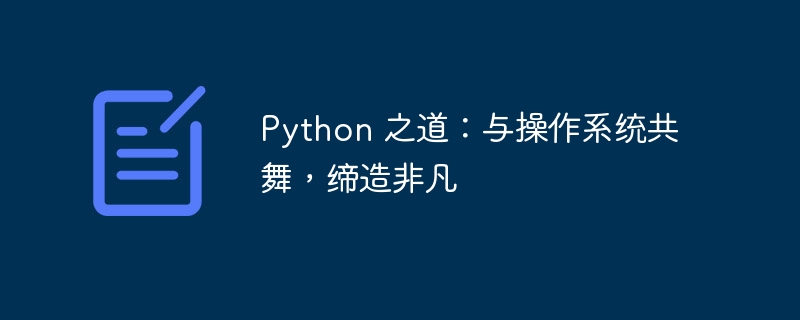

Fighting side by side with system calls
python provides multiple ways to access system functions. The most direct way is to use system calls. System calls allow programs to communicate with the operating systemkernel. Python provides modules similar to os and subprocess, which encapsulate the underlying complexity of common system calls.
Through system calls, Python scripts can perform various tasks, such as creating and managing processes, reading and writing files, sending network requests, and controlling hardware devices. This enables developers to build rich applications that integrate seamlessly with the system.
The Art of Pipes and RedirectsPipes and redirections are powerful mechanisms in Python for manipulating input and output. Pipes allow the output of one program to be used as input to another program. For example, the following code uses a pipe to pipe the output of the
grep command to the wc command:
import subprocess
p = subprocess.Popen(["grep", "Python"], stdout=subprocess.PIPE)
out, err = p.communicate()
print(out)
Redirection allows the input or output of a program to be redirected to a file or other program. For example, the following code redirects the output of the
command to the file output.txt:
import subprocess
with open("output.txt", "w") as f:
subprocess.call(["ls"], stdout=f)
By clever use of pipes and redirections, Python
can build complex scripts that can connect different commands and processes to automate tasks and process complex data flow.
Ingenious use of signals and eventsSignals are a mechanism by which the operating system notifies processes of events, such as keyboard interrupts or termination requests. Python allows signal processing using the
signal module. Developers can define handler functions that are executed when specific signals are received.
Events are another type of system event that usually represent the completion of an asynchronous operation. Python's
io<strong class="keylink"> module provides an event loop </strong> framework that allows programmers to handle concurrent events. This is crucial for building responsive web applications and handling large numbers of parallel tasks.
Python also allows interaction with the
shell environment. This is useful for taking advantage of the shell's powerful command line utilities and scripting capabilities. External commands can be executed through the shell using the subprocess module as follows:
import subprocess
subprocess.call(["echo", "Hello, Python!"])
By leveraging the shell, Python programmers can enhance the functionality of their applications, extend their functionality and integrate with the broader system ecosystem.
Dancing with the operating system is a key aspect of Python development. By understanding system calls, pipes and redirections, signals and events, and interacting with the shell, Python programmers can build powerful, efficient, and flexible applications. This will unlock the full potential of Python, making it a powerful tool for developers to face modern software challenges.
The above is the detailed content of The Python Way: Dancing with the Operating System to Create Extraordinary Things. For more information, please follow other related articles on the PHP Chinese website!




